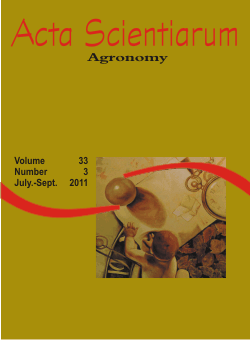<b>Influence of displacement speed in the performance of a precision no-till planter in northern Rio de Janeiro State</b> - doi: 10.4025/actasciagron.v33i3.6085
Keywords:
mechanical damage, slippage, seeding depth, field capacity
Abstract
The objective of this work was to evaluate the influence of displacement speed in the performance of a no till planter. The tests were performed in the experimental area of the Universidade Estadual do Norte Fluminense Darcy Ribeiro, located in Campos dos Goytacazes, Rio de Janeiro State, Brazil. The experiment was carried out in a randomized block design, using two speeds of 2.5 and 4.4 km h-1, with 16 replications. For sowing, the UENF 506-8 hybrid corn, with row spacing of 0.9 m and theoretical 11 cm spacing between seeds was used. When the displacement speed was intensified, there was an increase in planter wheel slippage, effective field capacity, planting depth, plate distribution mechanism speed and the occurrence of doubles. There was a decrease in the number of seeds per meter and exposed seeds with an increase in planter speed. The seeds that did not pass through the plate distribution mechanism reached a germination rate of 98%, while, both in speeds of 2.5 and 4.4 km h-1 they showed 95.3% germination, which represents a reduction of 2.7% due to mechanical damage caused by the planter plate distribution mechanism.Downloads
Download data is not yet available.
Published
2011-04-11
How to Cite
Garcia, R. F., Vale, W. G. do, Oliveira, M. T. R. de, Pereira, Érica M., Amim, R. T., & Braga, T. C. (2011). <b>Influence of displacement speed in the performance of a precision no-till planter in northern Rio de Janeiro State</b> - doi: 10.4025/actasciagron.v33i3.6085. Acta Scientiarum. Agronomy, 33(3), 417-422. https://doi.org/10.4025/actasciagron.v33i3.6085
Issue
Section
Agricultural Engineering
DECLARATION OF ORIGINALITY AND COPYRIGHTS
I Declare that current article is original and has not been submitted for publication, in part or in whole, to any other national or international journal.
The copyrights belong exclusively to the authors. Published content is licensed under Creative Commons Attribution 4.0 (CC BY 4.0) guidelines, which allows sharing (copy and distribution of the material in any medium or format) and adaptation (remix, transform, and build upon the material) for any purpose, even commercially, under the terms of attribution.
2.0
2019CiteScore
60th percentile
Powered by 

2.0
2019CiteScore
60th percentile
Powered by 



















































